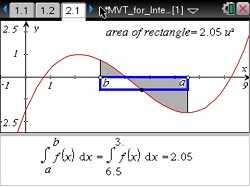MVT for Integrals

MVT for Integrals
Demonstrate how the average value of a function over an interval is related to the definite integral.
- Describe the statement of the Mean Value Theorem for Integrals in terms of graphical representation
- Describe how the Mean Value Theorem for Integrals relates to the average value of a function
- Explain why the condition of continuity is needed in the hypothesis of the Mean Value Theorem for Integrals to guarantee the existence of a point at which the function attains its average value
- definite integral
- average value of a function
This lesson provides a graphical representation of the Mean Value Theorem for Integrals to demonstrate how the average value of a function over an interval is related to the definite integral. As a result, students will:
- Change the endpoints of intervals to make connections between the definite integral (the area bounded by the graph of f(x) and the x-axis) and a corresponding rectangular area.
- Discover that if a function f(x) is continuous it is always possible to construct a rectangle of height f(c) such that its area is equal to the definite integral and that this value f(c) is the average value of the function over the given interval.
- Use graphical representations of the Mean Value Theorem for Integrals to determine the average value of functions.
- Recognize conditions under which the existence conclusion of the Mean Value Theorem does not hold.
Vernier EasyData,Vernier EasyLink and Vernier EasyTemp are registered trademarks of Vernier Science Education.

